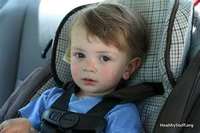Buckle Up the Right Way: Motor Vehicle Child Safety Restraints
 |
Following federal child safety restraint guidelines decreases the rate of fatal and orthopaedic injuries
ROSEMONT, IL--June 6, 2013: Supplemental child restraints should be used by all children through age 8. When appropriate child safety restraint systems--based on a child's age and weight--are in use during motor vehicle crashes, the rates of mortality and serious injury significantly decrease. Most parents don't know that their older children--ages 4 to 8--should use additional measures to protect them from serious injury or death in case of a crash.
In a literature review appearing in the June 2013 issue of the Journal of the American Academy of Orthopaedic Surgeons (JAAOS), researchers highlight current North American child safety restraint systems usage recommendations and injury rates. The study found that even though most children up to age 3 were protected properly, almost half of the children killed were under age 5 and completely unrestrained in the vehicle.
According to the Centers for Disease Control and Prevention's 2010 Fatal Injury Reports, National and Regional, motor vehicle crashes between 1999 to 2010 were the leading cause of death in children aged 1 to 17 years. But, child safety seats can reduce the risk of fatal injury by 71 percent for infants and 54 percent for toddlers in passenger cars.
"The safest position for a child is the rear center seat because side impact crashes are more likely to cause serious injury and fatality, with the greatest risk associated with perimeter seating," says lead author Dr. Walter H. Truong, a pediatric orthopaedic surgeon at Gillette Children's Specialty Healthcare in Minnesota. The American Academy of Pediatrics advises parents to keep toddlers in rear-facing car seats until age 2.
Child Safety Restraint Systems -- By the Numbers
- Less than half of parents (46%) knew that children 4 to 6-years old, weighing 40 to 60 pounds, should travel in a booster seat.
- Forty-six percent of fatally injured children younger than age five were completely unrestrained during motor vehicle crashes.
- Ninety seven percent of parents with children up to 3 years of age reported the use of a restraint system compared with only 42 percent of parents with children aged 4 to 6 years.
- Even when safety restraints are used, up to 99 percent of children in certain age groups are not using the recommended restraints.
- "Seat belt syndrome" is a real danger for children in the 4 to 8-year age group who are prematurely graduated to seat belts alone. The improperly positioned seat belt can cause hip and abdominal contusions, intra-abdominal injuries, pelvic fractures and lumbar spine injuries.
- Booster seats minimize abdominal injuries that have been associated with the use of seat belts alone in the 4 to 7-year age group.
- Forward-facing car seats reduced serious injury and hospitalization for children aged 1 to 4 years old by 78 to 79 percent compared to seat belts alone.
- The back seat is the right place for children. In the presence of dual airbags, children younger than 10 years of age who were involved in a frontal collision were 34 percent more likely to be killed in the front seat.
Findings and Recommendations
- Rear-facing child seats should be used for children at least until 2 years of age and at least 20 pounds. These seats can be used beyond these guidelines if the child fits comfortably in the seat.
- Forward-facing child seats should be used for children through 4, or until the child weighs more than 40 pounds. They can be used beyond this time if the child still fits comfortably.
- Booster child seats should be used for children aged 5 to 8, or for children weighing 40 to 60 pounds. These can reduce or eliminate injuries from seat belt position in case of a collision.
- Children should always ride in the back seat, especially when dual air bags are present.
- Lack of awareness, rather than cost, is the main reason for improper restraint system use and airbag knowledge. Appropriately targeted education programs should continue to be developed for those who put children in restraint systems.
- Physician education and active participation in patient education regarding proper use of child safety restraints is vital to optimizing parental understanding of proper recommendations.
June 3, 2013 Full JAAOS Table of Contents
- Guest Editorial: Orthopaedic Sports Medicine 2013
- Automobile Safety in Children: A Review of Current North American Evidence and Recommendations
- Shoulder Arthroscopy Basic Principles of Positioning, Anesthesia and Portal Anatomy
- Nerve Injury Complicating Multiple Ligament Knee Injury: Current Concepts and Treatment Algorithm
- Lower Extremity Arthroplasty in Inflammatory Arthritis: Preoperative and Perioperative Management
- Basic Principles for Conducting Human Research in Orthopaedic Medicine
- Madelung Deformity
For more AAOS news, visit the News Bureau
Follow AAOS on Twitter
Follow AAOS on Facebook
A Nation in Motion
More than one in four Americans have bone or joint health problems,
making them the greatest cause of lost work days in the U.S. When
orthopaedic surgeons restore mobility and reduce pain, they help people get
back to work and to independent, productive lives. Orthopaedic surgeons
provide the best value in American medicine in both human and economic
terms and access to high-quality orthopaedic care keeps this "Nation in
Motion." To learn more, to read hundreds of patient stories or to submit
your own story, visit ANationInMotion .


